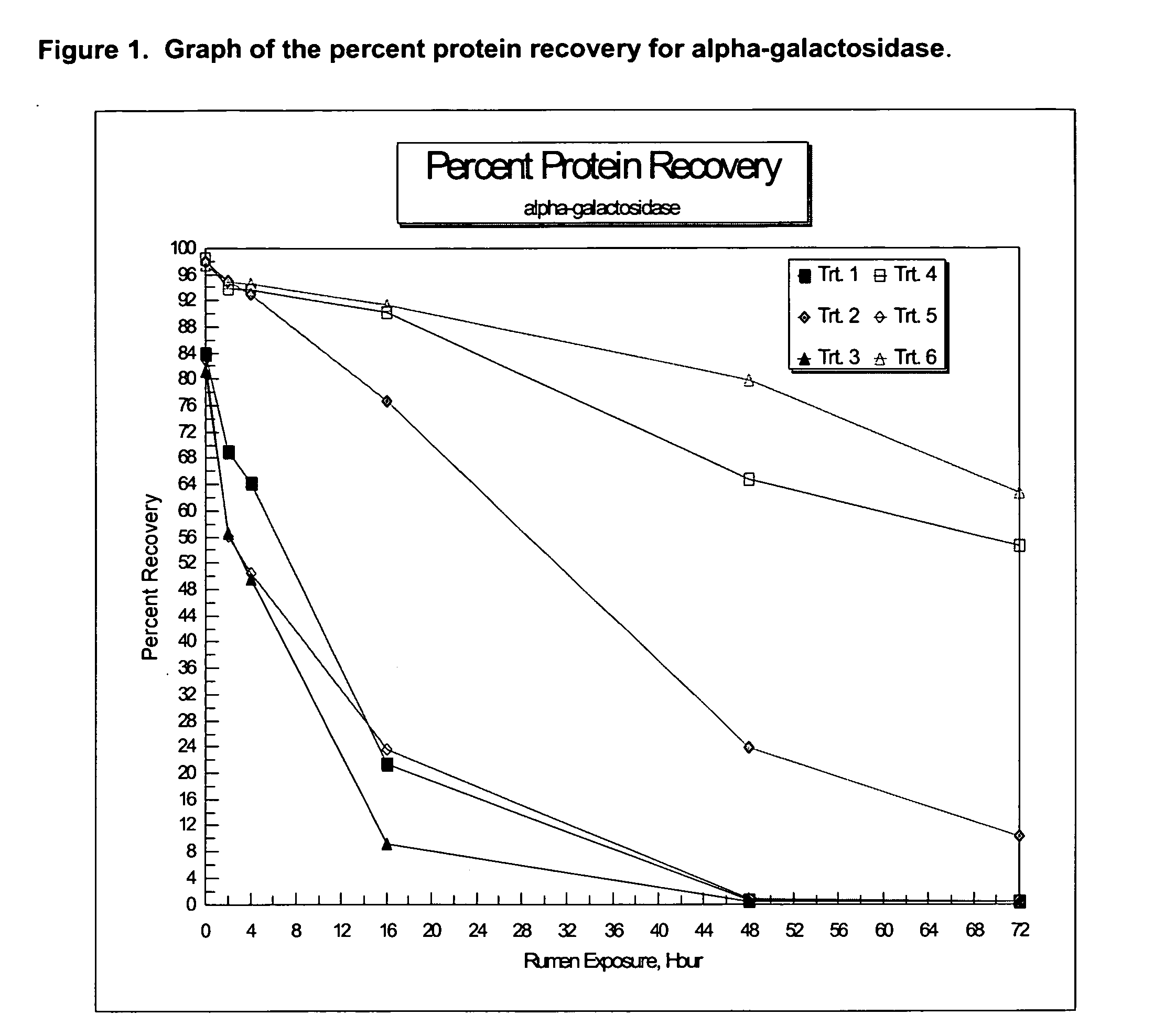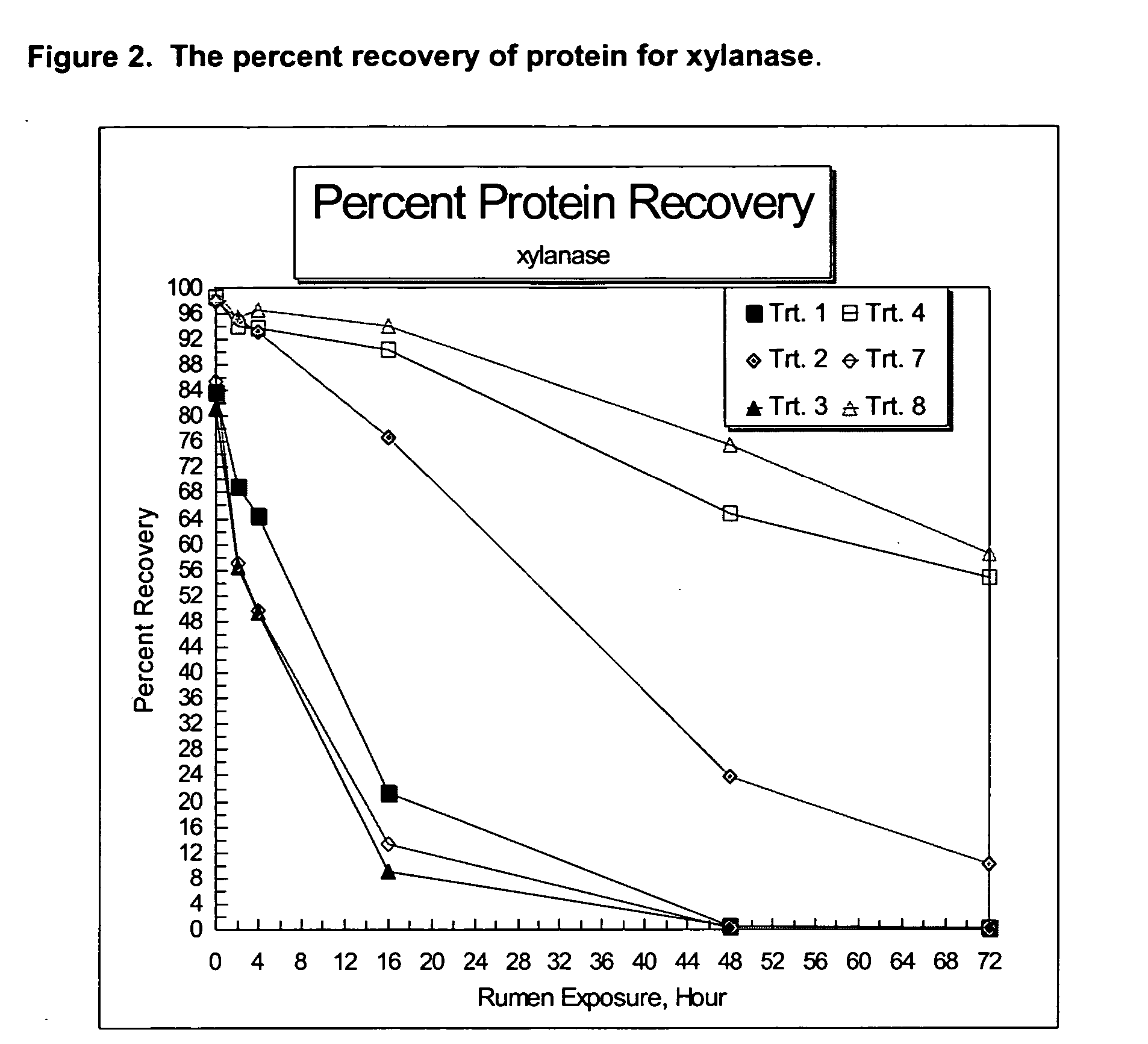Compositions and methods providing rumen bypass protein in ruminant diets
a technology of bypass protein and ruminant diet, which is applied in the field of diet compositions, can solve the problems of increasing the demand for bypass protein, force, heat and pressure, and protein synthesis by rumen fermentation may not meet the animal's demands for metabolizable protein,
- Summary
- Abstract
- Description
- Claims
- Application Information
AI Technical Summary
Benefits of technology
Problems solved by technology
Method used
Image
Examples
example 1
Rumen Bypass Protein Increase by Addition of an Enzyme
[0088] A study was performed to assess the effect of the addition of the enzymes alpha-galactosidase and xylanase on rumen bypass protein content of moist heat treated soybean meal.
[0089] This example utilized an artificial rumen fermentation system (Ankom Daisy System, Ankom Technology, Fairport, N.Y.) and a dacron bag technique using 8 treatments as described below. The bags were incubated for time periods of 0, 2, 4, 16, 48, and 72 hours. The milligrams of dry matter and protein (nitrogen×6.25) remaining in the dacron bags was expressed as a percentage of the original weight of dry matter and protein placed in the bags (percent recovery). The results showing RUP content for each treatment is presented in Table 1: Effects of Moist Heat and Enzyme Treatment on Ruminal Degradation of SBM. The percentage of rumen undigested protein (%RUP) for the treatments after each incubation period was calculated by dividing the residual pro...
example 2
Effect of Organic Acid
[0095] A study was performed to assess the effects of the addition of ascorbic acid and citric acid on bypass protein content of SBM. Samples of SBM were prepared by mixing the SBM with an amount of an organic acid and 25% water (v / w) in a small drum mixer for 3 minutes, treating with moist heat by heating the mixed composition at 105° C. for 4 hours, weighing the samples, and heating at 50° C. for a time sufficient to dry the composition to 12% moisture, as estimated by weight loss.
[0096] Ascorbic acid was added to the SBM samples in amounts of 0, 1, 2, 3, 4, 5, and 6% (w / w). After processing, RUP was assayed according to the procedure set forth in Example 1. The effect of ascorbic acid on RUP content of the moist heat treated SBM is shown in FIG. 4 and Table 3. Citric acid was added to the high protein SBM in amounts of 1, 3, and 5% (w / w). After processing, RUP was assayed according to the procedure set forth in Example 1. The effect of citric acid on RUP c...
example 3
Effect of Enzyme, Yeast and Metal
[0097] A study was performed to examine the effect on the RUP content of the moist heat treated combination of an ethanol yeast biomass, an enzyme, and metal ions. An ethanol yeast biomass was examined alone or in combination with 6000 ppm of a blend of divalent zinc and manganese ions, or 0.01% of xylanase enzyme. The combined mixture was treated with moist heat according to the method set forth in Example 2. The RUP content of the resulting supplement was measured by the standard method set forth in Example 1 (16 hours in situ fermentation) and compared against SBM that had been moist heat treated and combined with an enzyme and metal ions.
[0098] The results of the study, shown in Table 4: RUP (% of CP) of Heat-Treated SBM and Ethanol Yeast Biomass, demonstrate that the moist heat treated combination of an ethanol yeast biomass with xylanase displays higher RUP than the moist heat treated ethanol yeast biomass itself. The moist heat treated combi...
PUM
 Login to View More
Login to View More Abstract
Description
Claims
Application Information
 Login to View More
Login to View More - R&D
- Intellectual Property
- Life Sciences
- Materials
- Tech Scout
- Unparalleled Data Quality
- Higher Quality Content
- 60% Fewer Hallucinations
Browse by: Latest US Patents, China's latest patents, Technical Efficacy Thesaurus, Application Domain, Technology Topic, Popular Technical Reports.
© 2025 PatSnap. All rights reserved.Legal|Privacy policy|Modern Slavery Act Transparency Statement|Sitemap|About US| Contact US: help@patsnap.com



